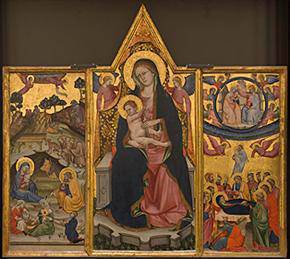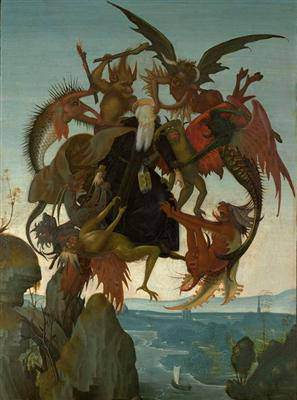
Master of The Beffi Triptych
The Madonna and Child with Scenes from the Life of Christ and the Virgin (The Beffi Triptych), early 15th century
Tempera on panel
Museo Nazionale d’Abruzzo, L’Aquila
Photo by Rob Shelley © 2009 National Gallery of Art
The National Gallery of Art presents The Beffi Triptych: Preserving Abruzzo’s Cultural Heritage
from June 15 to September 7, 2009
The first work of art to be transported out of the region of Abruzzo, Italy, in the aftermath of a violent earthquake, the triptych is one of the most important works from the National Museum of Abruzzo in the city of L’Aquila
]]>
The Beffi Triptych has been lent by the Soprintendenza dell’Abruzzo e la Direzione Regionale dell’Abruzzo. Its presentation at the National Gallery of Art is made possible by the Ministero per i Beni e le Attività Culturali and the Embassy of Italy in Washington, D.C.
The Madonna and Child with Scenes from the Life of Christ and the Virgin (The Beffi Triptych), a highlight from the collection of the National Museum of Abruzzo, L’Aquila, is named for the nearby town of Beffi, where it once adorned the Church of Santa Maria del Ponte. Painted in the early 15th century by an anonymous follower of the Sienese artist Taddeo di Bartolo, The Beffi Triptych, unlike many other works of art in the museum, suffered only minimal damage that has been repaired.
The wings of the triptych depict scenes from the life of the Virgin Mary, who appears in the central panel, enthroned with the Christ child beneath an elegantly brocaded canopy. The left wing features Christ’s Nativity, which takes place in a cave under the watchful gaze of an ox and an ass, following Byzantine tradition. Mary holds the swaddled infant while Joseph, at right, ponders the miraculous event. At the top, angels announce the birth to shepherds tending their flocks; below them, two shepherds adore the newborn child, and at the lower left, maidservants prepare his first bath. Represented at a smaller scale, the kneeling figure to the right wearing red and black stockings is the unidentified donor of the altarpiece.
The right panel portrays the Dormition, or Death of the Virgin, who lies on her funeral bier, surrounded by the 12 apostles. Angels scent the air with incense from censers incised in the gold ground, giving the scene a heavenly aura. The figure in the foreground represents the disbelieving priest who, according to legend, attempted to overturn Mary’s bier, but whose hands were frozen when he tried to commit that sacrilege. Above the Virgin and apostles, the Assumption of the Virgin is depicted with Christ holding Mary’s soul, which traditionally takes the form of an innocent, swaddled infant. At the top, Christ crowns Mary as Queen of Heaven.
The triptych was received at the Embassy of Italy on June 2 as the guest of honor of the celebration of Italian National Day, dedicated this year to the victims of the earthquake.
Follow us on:


